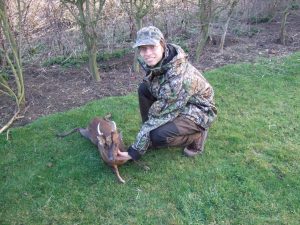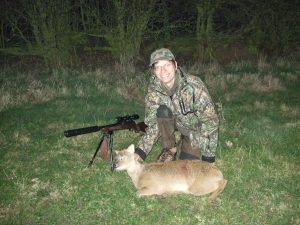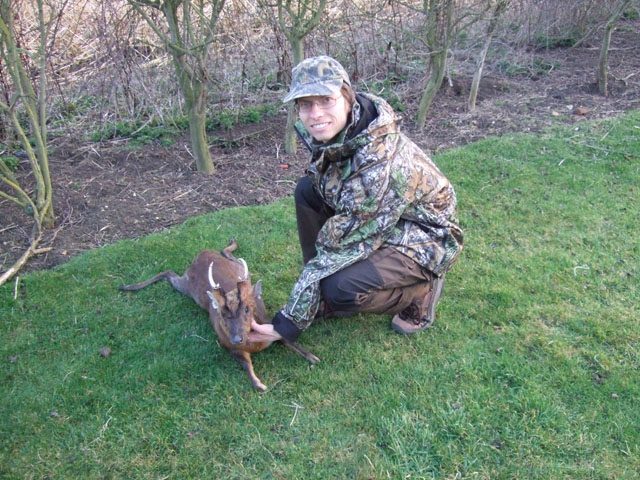Hunting for Muntjak and water deer in England
When hunting in England, you immediately think of the capital bucks in the south of England. However, England also has other very interesting game species that can only be hunted here worldwide. These two exotics are the Muntjak and the Chinese Waterwave (CWD), both of which are the canines which make them look something like vampires. Both species are pure herbivores. The hunting season begins in November and extends into March, so that both species can be hunted in the rather quiet time for us German hunters in February and March. After some research on the exotics, my decision was made to fly to England in February to pursue the hunt for these two species.
Due to the size of Muntjak and CWD smaller than a deer, I decided contrary to my normal approach this time not to take their own weapon, but to borrow one. The existing 30-06 and 243 Win are quite sufficient for the game and the concerns about the recoil puttygen ssh , as it partially occurs in Africa with 375H & H caliber weapons, are here completely unfounded. Another advantage is that in England mufflers are allowed, so that hunting is also possible for sensitive hunters without earmuffs. Said, after a long period of planning, I chose an area north of London in the Bedfordshire region. Most hunters hire a car in London and drive to the hunting area themselves, which also has the advantage of being more flexible if the hunt is successful in the past or if you want to do something in the evening. Since hunting was the main focus of my short stay PuTTY SSH proxy , I decided to pick up the airport and was already expected by my guide Mike on arrival in London.
The two-hour drive to the farm, we already used to talk about the nature of the hunt and the biotopes of the two exotics. Arrived at the farmhouse, we made with Jason the second guide a plan for the next day and adopted a group of Dutchmen who had the 3 days before very successful in 4 Muntjaks gewaidwerkt. The trophies I saw raised my anticipation for the next day. As if in flight, the night passed in the simple but cozy B & B house and after an English breakfast we started early in the morning.
The first day
The first day was reserved for the Muntjakjagd. After a 20 minute drive we reached the hunting area, a larger forest with many forest / meadow edges and a lot of undergrowth, the ideal habitat for Muntjaks. We first stalked along the edge of the forest towards small depressions in the forest, where we already saw some younger male muntjaks and some female ones. In addition to Muntjak, some jumps also pulled deer across the pasture and disappeared in the forest when they noticed us. The older muntjaks are usually in the undergrowth and duck during the day to avoid being discovered. But since February and March are rutting, you also have the chance to hunt the muntjaks at the edge of the forest when they face the geisen. This should not be the case for us this day and since the first attempts showed only young muntjaks, we tried our luck within the forest which offered some blasphemies.
Again and again we see muntjaks jumping off in the undergrowth, unfortunately they always discover us before we can see them. At around 11 o’clock we finally stopped the hunt, as the Muntjaks lay down for lunch and a hunt makes no sense, at 15:30 we decided that we would like to carry out our evening talk in another place.
After a short lunch in one of the restaurants in town and a little sleep, it started punctually at 15:30 again. This time we found ourselves in a larger forest area with alternating high forest, thickets and open spaces with undergrowth and grass. For seven weeks my guide tried in vain to shoot a special muntjak in this area, but he had often seen him mostly only the fronds, since the smart muntjak hunters always saw coming. With this information in mind, we moved very carefully on the forest trails from one thicket to the next to blow off the open spaces. The 30-06 loaner was set to minimum magnification, so we would not lose any time adjusting to the short distance that we had to expect. The first thickets were turned over without a sighting. At the third, however, we suddenly heard a crash coming straight at us and before we knew it, a young muntjak raced out of the thicket between us and nearly knocked my leader off his feet. As fast as he came he was gone in the next thicket, a short time later we discovered the reason for the “lightning attack” a very strong male Fox was in the undergrowth and had startled the Muntjak.
After this action, we went on soft feet again focused on the next free space. Suddenly we saw the tall grass wobble and hope for cover behind a shrubbery. With the binoculars we observed the grass, but could not discover anything Therefore, it meant to stalk closer to a better positioned tree. From the new position, we recognized the muntjak as it eats in the grass, the wind was good for us. Slowly the bipod was brought into position, the weapon placed and brought into attack. Just no hasty movements, I thought, since the muntjak is very attentive, the easiest movement can decide between success and failure. The Muntjak was pulled a little closer and now eats about 50m in front of us, the target spike covers the chamber and the next time the head raises the shot breaks, the Muntjak falls in the bang and after 7 futile weeks we had killed the monster muntjac. After the obligatory pictures we carried the muntjak back to our jeep and drove back to the farm where Jason was already waiting for us and took a look at the muntjak.

day 2
For the next day we agreed that I would stalk with Jason on Chinese water revolutions. For this we had to drive about 1 hour, as water reindeer occur more in open park / field landscapes and less in the forest like the Muntjaks. The next morning we were a little earlier to plan for the longer journey. Our first station was a plantation for elephant grass which is used for energy production. In this plant the water reindeer find ideal shelter and can change directly to the surrounding meadows. There were mowing lanes between the elephant grass https://puttygen.in , so that the water lark had to leave the cover only briefly, on the other hand, this also offered good opportunities for us hunters to get to the water lure. So we stalked the forest through the elephant grass, but mainly saw smaller waterlogging and my guide decided to go to a second hunting area nearby. These were open areas with smaller fields and hedges, a real small game paradise.
No sooner had we started our stalking we heard dog barking in the distance. At first we thought nothing of it and continued our stalking and saw also some rabbits, pheasants and occasional female Wasserrehe. Approximately 10 minutes later, the barking of the dogs came right up to us followed by loud horse galloping. We had to realize that on this day not only we were out here on water lure but in addition a traditional fox hunt on horseback with dogs took place, which of course was carried out strictly according to the new laws on a cold artificial fox track, which my guide told me immediately when he saw the riders. Since the fox hunt caused too much anxiety, we decided to end the hunt and hunt again in the area in the afternoon.
Punctually at 15:00 clock went back to the said area and now we had it really for ourselves without fox hunters. We stalked all the fields and hedges and saw again different water levels. However, these first discovered us or, if not, were mostly female or young bucks. We saw two old good bucks, but we could not approach the shooting range. As we made our way back Jason spotted a solitary water turn at a distance. The speech with the scope gave a good buck. We now had two enemies against us, for one, the buck stood on an open space and thus could overlook everything, on the other hand, it already began to dawn and we were not allowed to lose much time.
In rapid prowling, but always crouched, from hedge to hedge, we approached the said open space until we came to the last elongated hedge. Since there was no way out, we had no choice but to crawl through a small hole under the hedge. Arrived on the other side, we were already on the open space and could still see the buck about 160m in front of us. Carefully we positioned the 243 Win with silencer and attached bipod and I got ready. Meanwhile, the dusk was already well advanced, so that the buck appeared relatively small and inconspicuous on 160m in a 6-fold magnifying riflescope without luminous dot. Despite the darkness, I was able to bring the buck into the riflescope and operated the trigger as the buck stood wide, but as supposedly no shot broke and the buck was still standing, I pressed the trigger again, whereupon the buck was no longer visible in the riflescope, but I again had not heard or felt a shot. My guide patted my shoulder contentedly and said the goat was lying. Only now I realized what had happened, out of habit, I had my earmuffs on, but shot for the first time with a gun with muffler which made the shot no bang was heard and the recoil of the .243 also negligible or not available thanks to the tension was. The shot was good, so that the buck staggered briefly, which I interpreted after the shot in the riflescope he would still stand, and then went to the ground on the spot.

Overjoyed with the success, we went to the shotgun, gave him the last bite and I received the break from Jason. Then we drove back to the farm where Mike had already cut my Muntjak from the previous day as a Cape. As I already had my two desired trophies after 2 out of 3 booked days, I used the last day to relax and explored the place where I stayed in the B & B house.
The next day early in the morning we went back to London to the airport to start the return journey. In the luggage I had memories of a beautiful hunt, which is relatively easy to reach and with 2-3 hunting days for short trips is suitable, on the other hand by the not too heavy stalking and the mostly flat terrain also suitable for hunters is the less strenuous hunts prefer.
